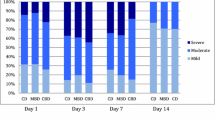Abstract
Tonsillectomy is one of the oldest and most common procedures worldwide. This surgery is performed by different methods include cold dissection technique (CDT) and bipolar electrocautery technique (BET). Assessment and comparison of postoperative outcomes in cold dissection and bipolar electrocautery is the aim of present study. This randomized controlled clinical trial study was conducted as double-blind on 534 patients. The enrolled patients underwent tonsillectomy in Vali-e-Asr Hospital of Birjand city from Oct. 2013–Oct. 2015. Al patients systematically allocated into two groups treated with cold dissection or bipolar electrocautery methods. Intensity of throat pain scores, Otalgia, analgesic consumption, resume normal diet, body temperature and also wound healing on 10th day after operation were measured and compared between the two groups. The gathered data were analyzed by SPSS software (Ver-22) and using necessary tests. The differences between studied groups less than 0.5 (p < 0.05) considered significant statically. 51.7 and 50.6% in the CDT and the BET groups were male respectively. In comparison between the groups the mean of pain scores 4 and 24 h after operation in the BET group were higher significantly (p < 0.001). Otalgia only 4 h after surgery was higher significantly in the BET group (p = 0.008). All the other studied parameters were significantly more desirable in the CDT group (p < 0.001). According to the findings of present study it seems that the CDT is safer and more favorable than the BET in tonsillectomy.
Similar content being viewed by others
References
Ali M, Rafique A, Dastgir M, Rashid M, Maqbool S, Bashir S (2014) Comparison of bipolar electrocautry and cold steel dissection methods for tonsillectomy. Pak Armed Forces Med J 64(1):34–38
Khan MA, Khan ZU, Akram S, Rafique U, Usman HB (2015) Comparison of postoperative pain and hemorrhage in children after tonsillectomy with bipolar diathermy technique versus tonsillectomy with cold steel dissection and silk ligature. Pak Armed Forces Med J 65(6):739–742
Adoga A (2011) Cold versus hot dissection tonsillectomies: the Nigerian experience. East Cent Afr J Surg 16(3):64–68
Vithayathil AA, Maruvala S (2017) Comparison between cold dissection snare method and bipolar electrodissection method in tonsillectomy. Res Otolaryngol 6(2):17–22
Guragain R, Bhusal C, Adhikari P, Pokharel R (2011) Intraoperative blood loss and operating time in tonsillectomy: Is electrodissection better? Nepal J ENT Head Neck Surg 1(1):6–7
Stavroulaki P, Skoulakis C, Theos E, Kokalis N, Valagianis D (2007) Thermal welding versus cold dissection tonsillectomy: a prospective, randomized, single-blind study in adult patients. Ann Otol Rhinol Laryngol 116(8):565–570
Al-Juboori AN (2016) Safety of cold tonsillectomy techniques: comparison between wired snare and inferior tonsillar pole ligation methods. Int J Otorhinolaryngol 3(1):1–4
Raut V, Bhat N, Kinsella J, Toner J, Sinnathuray A, Stevenson M (2001) Bipolar scissors versus cold dissection tonsillectomy: a prospective, randomized, multi-unit study. Laryngoscope 111(12):2178–2182
Kousha A, Banan R, Fotoohi N, Banan R (2007) Cold dissection versus bipolar electrocautery tonsillectomy. J Res Med Sci 12(3):117–120
Pizzuto MP, Brodsky L, Duffy L, Gendler J, Nauenberg E (2000) A comparison of microbipolar cautery dissection to hot knife and cold knife cautery tonsillectomy. Int J Pediatr Otorhinolaryngol 52(3):239–246
Paradise JL, Bernard BS, Colborn DK, Janosky JE (1998) Assessment of adenoidal obstruction in children: clinical signs versus roentgenographic findings. Pediatrics 101(6):979–986
Mofatteh MR, Golbui SH, Hassanzadeh Taheri MM, Hossaini SM, Jannesar Borugerdi Y (2013) Survey of the efficacy of antibiotic therapy on complications consequent of tonsillectomy and adenotonsillectomy. J Birjand Univ Med Sci 20(3):211–219
Mofatteh MR, Meghdadi S, Sharifzadeh G, Salehi F, Taheri MMH A (2015) Study of the Complications of Bipolar Electrocautery Tonsillectomy in Patients Admitted to Vali-e-Asr Hospital of Birjand. J Surg Trauma 3(3–4):33–38
Gendy S, O’Leary M, Colreavy M, Rowley H, O’Dwyer T, Blayney A (2004) Tonsillectomy–cold dissection vs. hot dissection: a prospective study. Ir Med J 98(10):243–244
Silveira H, Soares JS, Lima HA (2003) Tonsillectomy: cold dissection versus bipolar electrodissection. Int J Pediatr Otorhinolaryngol 67(4):345–351
Manandhar S, Bhandary S, Chhetri S, Khanal B, Shah S, Sah B et al (2016) Bacteriological evaluation of tonsillar surface and tonsillar core micro flora in patients undergoing tonsillectomy. Health Renaiss 12(3):149–153
Chettri S, Bhandary S, Nepal A, Joshi R, Natesh V, Sah S et al (2014) A single blind controlled study comparing bipolar elecrocautery tonsillectomy to cold dissection method in pediatric age groups. Health Renaiss 11(3):270–272
Bukhari MA, Al-Ammar AY (2007) Monopolar electrodissection versus cold dissection tonsillectomy among children. Saudi Med J 28(10):1525
Fida AR, Sendi KS (2013) Assessment of postoperative pain scores in thermal welding and conventional tonsillectomy techniques: a randomized control study. Egypt J Ear Nose Throat Allied Sci 14(2):107–111
Yilmaz M, Duzlu M, Catli T, Ustun S, Ceylan A (2012) Thermal welding versus cold knife tonsillectomy: a prospective randomized study. Kaohsiung J Med Sci 28(5):270–272
Hashemi M, Salmani A, Abtahi M (2002) Post tonsillectomy morbidities: bipolar electrosurgical scissor vs classic method. J Res Med Sci 7(4):324–327
Nunez DA, Provan J, Crawford M (2000) Postoperative tonsillectomy pain in pediatric patients: electrocautery (hot) vs cold dissection and snare tonsillectomy—a randomized trial. Arch Otolaryngol Head Neck Surg 126(7):837–841
Pham V, Rana N, Underbrink M, Siddiqui F, Mukerji S, Pine H (2014) Postoperative outcomes in coblation versus electrocautery tonsillectomies. Int J Otolaryngol Head Neck Surg 3(01):32
Alam M, Atiq M, Mamun A, Islam M (2011) Comparison between bipolar diathermy tonsillectomy and cold dissection tonsillectomy. Mymensingh Med J MMJ 20(1):104–109
Acknowledgements
This article is based on some results of project in code: 1012 and was supported by Vice-chancellor for Research and technology in BUMS. The authors are very grateful to thank all patients and also parents of children patients who participate in this project.
Author information
Authors and Affiliations
Corresponding author
Ethics declarations
Conflict of interest
The authors declare that there is no conflict of interest for this article.
Rights and permissions
About this article
Cite this article
Mofatteh, M.R., Salehi, F., Hosseini, M. et al. Postoperative Outcomes in Cold Dissection Versus Bipolar Electrocautery Tonsillectomy: A Randomized Double-Blind Controlled Study. Indian J Otolaryngol Head Neck Surg 71 (Suppl 1), 182–187 (2019). https://doi.org/10.1007/s12070-017-1204-4
Received:
Accepted:
Published:
Issue Date:
DOI: https://doi.org/10.1007/s12070-017-1204-4




